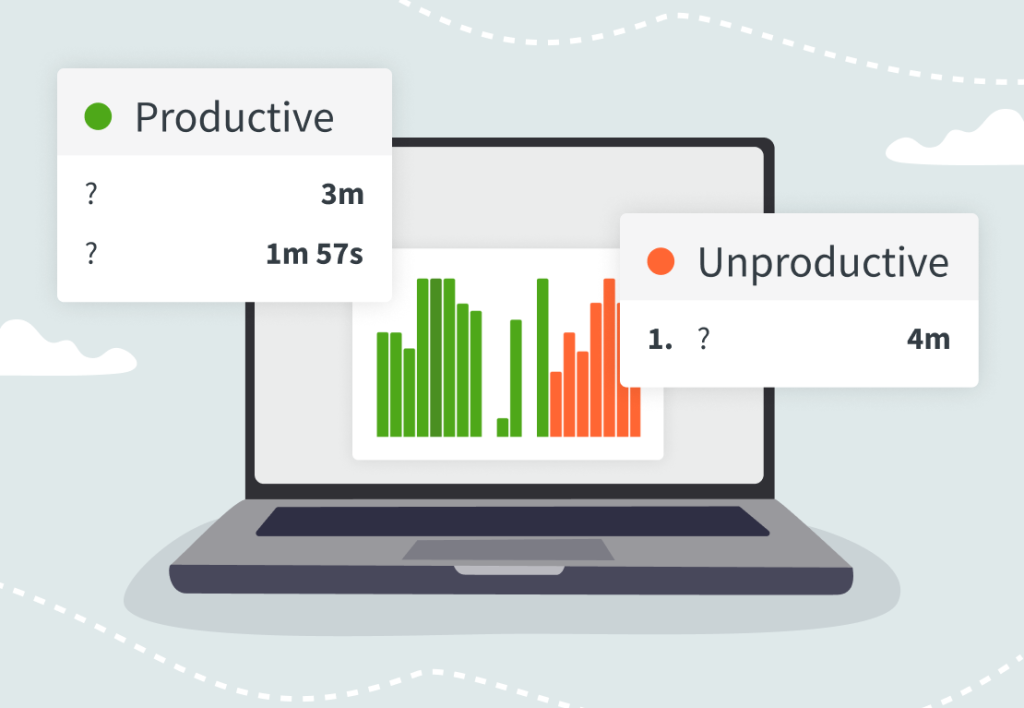The most and least productive apps of 2024—how do you compare?

We’ve recently rerun our yearly data dive into the most used productive and unproductive apps on DeskTime—the work productivity software. Time to compare your own work patterns to other people across the globe!
As part of this study, we pulled data from 50,000+ active DeskTime users and listed their most used productive and unproductive websites and apps in 2024. The sample includes apps used by at least 500 DeskTime users. This is to exclude outliers and apps that are exclusively used by one large company.
A short note on what constitutes a productive or unproductive app:
The productivity or unproductivity of an app depends on who’s asking. What may be useful for some is a complete time-waster for others.
That’s why in DeskTime, managers can label apps and websites as productive, neutral, or unproductive according to how they’re perceived in their line of work.
A classic example is that Facebook and YouTube might count as productive apps for a social media manager. Whereas apps like WhatsApp, YouTube, and Netflix are distractions, not work—for virtually everyone. Despite that, their heavy usage during work hours remains unwavering over the years.
Want to get the most out of your time?
Try DeskTime for free!
Try free for 14 days · No credit card required.
By signing up, you agree to our terms and privacy policy.

Most-used unproductive websites of 2024
Without further ado, we give you the greatest time-wasters of the last year. Recognize any of your own favorite distraction apps on this list?
To give you an idea of how user behavior has changed over time, we’ve compared this year’s top 10 to the most unproductive websites of 2022 and 2023.
| # | 2024 | 2023 | 2022 |
| 1 | YouTube | YouTube | YouTube |
| 2 | |||
| 3 | |||
| 4 | DeskTime | Skype | Netflix |
| 5 | ChatGPT | Netflix | Spotify |
| 6 | Spotify | MS Teams | Skype |
| 7 | Gmail | Slack | Twitter (X) |
| 8 | Amazon | Spotify | Slack |
| 9 | Netflix | Gmail | Amazon |
| 10 | Twitter (X) | VLC Media Player |
As you can see, there are no dramatic changes since last year and even the years before. Years go by, but the top 3 unproductive apps still stand the test of time. However, there are some interesting nuances to how the rest of the top 10 has evolved.
Top 3 unproductive apps hold their ground
People will always need to unwind and socialize—maybe that’s why apps that cater to these needs are in high demand. Still, other distractions like video games (even good old Solitaire), and messaging apps like Telegram, have stayed behind the line. So what makes these top 3 apps so special?
YouTube
With 2.5 billion users worldwide, YouTube leads the time-waster app parade. No surprise there since YouTube is the second most visited website in the world, with 42.9% of the online global population being YouTube’s monthly active users.
That said, don’t rush to reproach employees who use YouTube during work hours. Besides entertainment, YouTube offers a plethora of educational videos, and content that can serve as a great introduction into complex subjects.
Even more, YouTube can be used as a marketing platform for businesses. After all, 62% of businesses are already using YouTube as a channel to post video content, so maybe you should, too?

73% of WhatsApp users in the US use the app at least once a day, and 100 billion messages are sent via WhatsApp daily. No wonder WhatsApp is an omnipresent distraction, chipping away at your attention both on your computer and smartphone.
The intensity of using WhatsApp for personal or business communication may vary from country to country, but one thing is clear—this app has proliferated so much that it’s likely you’ll find at least some of your work contacts there. However, be mindful if you notice WhatsApp at the top of your (or your team’s) unproductive apps, as there may be an issue with staying focused and avoiding distractions.
Facebook has kept its place as a top unproductive app for as long as since our first study in 2014. This ubiquitous platform has come out unscathed from various privacy scandals, #DeleteFacebook Movement, and the subsequent Meta’s stock price plunge.
Facebook’s multifariousness may be one of the cornerstones of its success, as this app is no longer only about chatting, but also about seeking information, promoting your business, buying used items, etc. People who aren’t on Facebook will face communication limitations sooner or later, and that’s why this app isn’t going anywhere—not from our lives, nor the unproductive app top.
The rest of the top 10: An interesting trend
While the top 3 remains firmly entrenched throughout the years, the remaining apps in the ranking reveal some interesting changes.
Here’s our theory: the shift in positions may be interpreted as remote work dropping in popularity. This is evidenced by the drop of Netflix and disappearance of MS Teams. The rise of Spotify may also be viewed as people listening to more music during work time—perhaps in the office to drown out the workplace bustle? Whereas Amazon’s return to the top points to the rise of workshopping—another personal activity that can be “taken care of” in the office and during work hours, without attracting much attention.

Invite structure in your workday!
Our all-in-one time management solution works wonders
What are work apps doing at the top of the unproductive website list?
The answer is that it’s no coincidence or mistake. Work-related applications have made it into the unproductive app top 10 since we started publishing them a decade ago.
There can be several reasons why this happens:
- Sometimes an app is set as “unproductive” or “neutral” by default. This is often overlooked by DeskTime account admins or owners in companies who have access to changing this setting according to their company’s preferences. Learn how to change the productivity level of an app in this FAQ.
- Some companies may want to limit unproductive chatting that often occurs in work messaging apps. It’s easy to get carried away by posting funny GIFs and giving your 2 cents in every Slack channel (which occasionally even outnumber the employees).
- Some managers may fear that work apps can be secretly used for slacking, e.g., imitating in-app action while actually doing something else.
- If an organization uses a particular messaging or email app, other apps may be viewed as unproductive. For example, if the company uses Outlook for official communication, Gmail – as a personal email app – may be constituted as unproductive.
- Some managers may want to measure how much time employees spend on their direct responsibilities or value-added work, as opposed to apps that only support it or that can be viewed as distractions.

Most-used productive websites of 2024
It’s time to look at the other side of the coin—the top 10 productive apps most used by DeskTime users last year. No great surprises there—Microsoft and Google family programs still dominate the list as they did in previous years, with Slack being the only other app fighting for its spot under the sun.
We can see that most apps are double awardees and have made it to the top of both lists. This is just a reminder that the productivity of an app is just a perspective that depends on your company’s line of work and communication style.
Interestingly, Microsoft’s remote tool has fallen slightly in the rankings, giving merit to our aforementioned theory that remote work, while still very popular, may be on the decrease.
| # | 2024 | 2023 | 2022 |
| 1 | MS Outlook | MS Outlook | MS Outlook |
| 2 | Gmail | MS Teams | |
| 3 | Google Docs | MS Excel | MS Teams |
| 4 | MS Excel | Gmail | MS Excel |
| 5 | VS Code | Google Docs | Google Docs |
| 6 | MS Teams | MS Remote Office | Gmail |
| 7 | Windows Explorer | Slack | |
| 8 | Microsoft Remote Desktop | MS Word | MS Word |
| 9 | Slack | Slack | Skype |
| 10 | MS Word | Skype | MS Remote Office |
The enduring allure of digital distractions
The top time-wasting apps in 2024, largely unchanged from previous years, remind us of how hard it is to resist digital distractions. On the flip side, the top productive apps, dominated by Microsoft and Google family programs, highlight the continued significance of these tools in enhancing workplace efficiency.
Two years ago, we predicted that ChatGPT would make one of these lists. It didn’t in last year’s ranking, where it barely scratched the top 50—of unproductive apps, at that. This year, the app is clearly a common office tool. Now the question becomes: will employers deem it a productive one in the coming years?
We hope our data gives you a valuable reflection on evolving work habits and preferences, offering insights that can inform decisions in your organization and help optimize your digital workspace for the year ahead.
Did you find this article useful? Give it a clap!
Psst! You can clap more than once if you really loved it 🙂